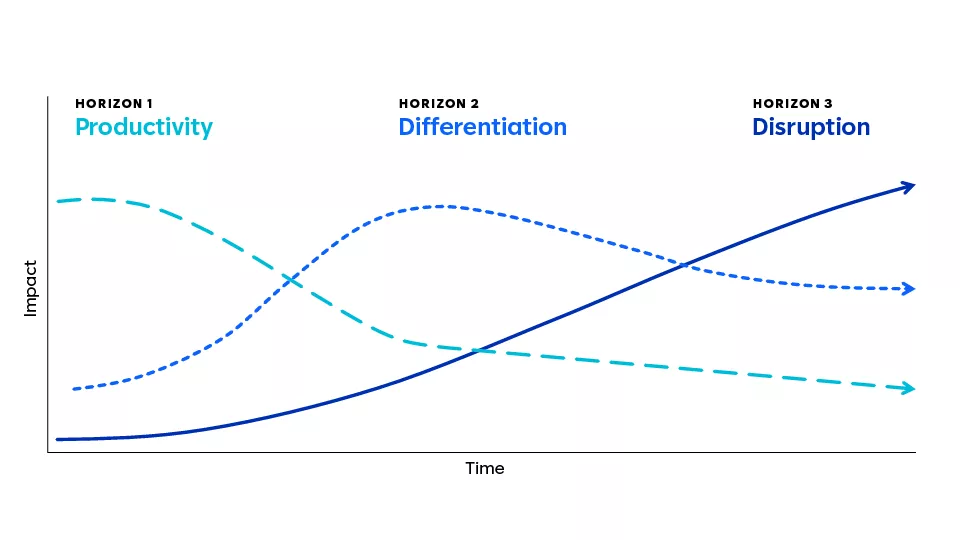The speed of AI: Is your organization adapting or stalled at the starting line?

The old change management playbook wasn’t made for artificial intelligence. Instead of adapting once, we need to become adaptive.
Despite 71% of organizations providing AI tools and 61% offering AI training, only 15% of leaders we surveyed in 2024 responded that they feel their company’s innovation is keeping pace with AI’s rapid advancements. And, compared to 28% in 2023, that number has decreased. What is holding back 85% of companies (and growing) from innovating as fast as AI is advancing, even though most of them already have AI?
It’s revealing that almost the exact same percentage of leaders who don’t think their companies are innovating at pace with AI—85%—are still applying traditional change management practices to AI adoption—86%. The old change management strategies weren’t designed for AI’s speed, scale, or impact. Instead, AI is one in a collection of environmental drivers that demand a fundamental shift in how organizations and people perceive and adapt to change.
To adapt and innovate at the speed of AI (or faster!), organizations need more than reactive, linear adjustments. They need:
Visions that are truly transformative: Don’t just imagine a better tomorrow, envision the future decades from now.
Systems that run faster and more dynamically with AI: Redesign systems for human-AI collaboration and AI-to-AI collaboration, orchestrated and choreographed by people working more creatively.
Workforces that are encouraged to “hack their jobs“: Give employees opportunities and agency to experiment with AI and evolve their own roles for the AI age.
While many traditional change management frameworks fall short, one familiar model aligns with the realities of AI: the Three Horizons. By viewing important AI initiatives like those above—vision-setting, systems redesign, and talent development—through the lenses of productivity, differentiation, and disruption, leaders can create a roadmap for their organizations to continuously adapt in ways that help them keep realizing ROI, no matter what the future holds. The return could be on your AI investments, but it could also be on investment opportunities that don’t even exist yet. That’s the power of not just adapting but becoming adaptive.
To make the roadmap to adaptability and ROI as practical as possible, we’ll combine the concept of the Three Horizons with the approach of a titan at the forefront of AI’s development.

Apply the Three Horizons to the AI journey—and set transformative visions for each
There’s a page in Meta’s internal culture guide first published in the earlier days of Facebook that reads: “We have a pretty good idea of where we want to be in six months and where we want to be in 30 years. And every six months, we take another look at where we want to be in 30 years to plan out the next six months.” This kind of long-range yet adaptive thinking is exactly what organizations need now.
The Three Horizons framework helps leaders start to think this way.
Horizon 1: Productivity
The first Horizon focuses on AI’s immediate impact: efficiency, optimization, and cost reduction. Leaders in this stage use AI to streamline operations and enhance productivity, but many get stuck here, treating AI as another automation tool rather than a strategic differentiator.
Transformative vision for productivity: AI is the ultimate enabler of workforce productivity, seamlessly integrated into every process. No more traditional workflows, just AI-augmented decision-making, multi-agent collaboration, and radical cost disruption (e.g., from $20 per customer service call to nearly free). Human productivity is measured by decision quality more than task completion.
Horizon 2: Differentiation
Horizon 2 is where AI starts to transform the business, allowing new value propositions, unique customer experiences, and innovative business models. The organizations that thrive here are those that use AI to evolve constantly, rethinking industry norms and reshaping customer expectations. Think of how Netflix capitalized on technology advancements in internet speeds, content delivery, and cloud infrastructure to essentially invent the Subscription Video on Demand (SVOD) business model and the idea of over-the-top (OTT) streaming services.
Transformative vision for differentiation: Human-machine collaboration is frictionless and AI-first networks of agents negotiate, optimize, and transact autonomously. Market leaders with high “innovation metabolism” absorb and implement new technological capabilities quicky. They also earn customer trust with infrastructure to verify authentic human interactions and experiences.
Horizon 3: Disruption
This is where AI-driven organizations don’t just compete—they lead movements. Horizon 3 is about rethinking the fundamental rules of business to create entirely new categories, operating models, and industries that wouldn’t have been possible without AI.
Transformative vision for disruption: AI is the foundation of new economies and AI-to-AI commerce dominates trade, with markets specifically for machine consumption. Traditional SaaS and service models are replaced by autonomous business capabilities where AI functions as the organizational operating system. Systems continuously rewrite themselves, and the role of humans is to orchestrate them.
The Three Horizons framework
 The Three Horizons framework can be applied to various kinds of business growth but has been made more relevant than ever with the rise of AI.
The Three Horizons framework can be applied to various kinds of business growth but has been made more relevant than ever with the rise of AI.
Enable through AI-accelerated systems that improve navigation
The Three Horizons and a transformative vision help guide maturity in thinking at any time in an organization’s journey. But leaders must also balance tomorrow’s transformation with today’s execution. Establish AI-accelerated systems that will help you reach incremental milestones long before your organization reaches its long-term goals—as soon as the first six months of your transformation, if you want to take a page (specifically that page) from Meta’s book.
Establishing these systems means being willing to redesign business processes for AI integration, which our research indicates only half of organizations were doing in 2024. Here’s how to be that half:
Productivity-driven six-month actions with examples
Strategically deploy specialist AI: Focus on narrow, high-value use cases where AI has proven capability, like customer service automation or contract review. Start with well-defined, high-cost processes, build domain-specific guardrails, and prioritize practical deployment over theoretical planning. For example, some of the first generative AI use cases United Airlines brought to production were in customer service, including a customer care copilot and enhancements to its messaging program for flight updates.
Get exponential ready: Redesign processes, like customer service triage, to scale efficiently under 100x volume. Plan for AI to become ten times more capable and one-tenth the cost within a year, supporting seamless AI collaboration and organizational readiness.
Normalize working with robocolleagues: Treat AI agents as team members, not tools. Launch an “AI fluency” program, establish AI-human collaboration protocols, create safe spaces for experimentation, and measure satisfaction while reducing AI anxiety across all team levels.
Differentiation-driven six-month actions with examples
Build your data advantage: Start collecting unique interaction data from AI deployments and map your data territory to identify proprietary datasets. Build synthetic data generation capabilities to create exclusive assets that will fuel your future AI advantage and drive innovation.
Customer intelligence revolution: Deploy AI agents to engage in 100x more customer conversations, turning previously unaffordable interactions into valuable touchpoints. Capture customer insights at an unprecedented scale, enabling personalized conversations that outpace competitors in learning and understanding customer needs.
Master rapid evolution: Focus on continuous AI-powered transformation by making experimentation a core capability. Transition from project-based thinking to rapid evolution, building systems that improve with every interaction and using learning velocity as a key metric.
Disruption-driven six-month actions with examples
Multi-agent orchestration: Begin to build infrastructure for AI systems to interact, shifting from individual AI tools to interconnected ecosystems. Start experimenting with agent-to-agent transactions, and lay the groundwork for a future where AI systems collaborate autonomously across industries.
Autonomous governance design: Develop frameworks for AI system accountability by creating metrics for oversight and transparent audit trails. Design autonomous governance structures now, ensuring control while enabling AI autonomy, setting the stage for competitive advantage through responsible AI decision-making.
Fluid system boundaries: Design systems capable of dynamic reconfiguration, anticipating the blurring of traditional company boundaries. Build capabilities that allow instant composition and decomposition, preparing your organization to thrive in a future of constant change and fluid operational structures.
Develop an adaptive workforce
Even though 61% of organizations were offering AI training of some sort by 2024, 63% of executives we surveyed still cited inadequate skills or resistance to change as key barriers to AI productivity gains. Coincidence? Or a sign that training isn’t effective—or at least sufficient on its own—to achieve real results? And if that’s just for productivity gains, a Horizon 1 aspiration, imagine how the AI skills and adaptability gap is hindering higher-order goals like differentiation and disruption.
To be future-ready, organizations need to help employees transcend mere skills acquisition to adapt to AI, break old habits, and develop trust in AI as a collaborator. Here’s how organizations can evolve their ways of working across the Three Horizons:
Productivity-driven six-month actions with examples
Skill-based architecture: Encourage a “hack your job” mindset where employees integrate AI into their roles and think of themselves as business technologists and citizen developers. Replace rigid job roles with dynamic skill sets, emphasizing AI fluency, critical thinking, and problem-solving. Host “promptathons” and agent-creation sessions where employees can experiment with AI tools, fostering innovation through hands-on learning. For example, Takeda Pharmaceuticals designed a comprehensive upskilling initiative in collaboration with Slalom to help empower its workforce with AI and foster an innovation mindset, resulting in a 91% increase in participants’ average AI proficiency levels.
Rethink leadership and management layers: Start shifting away from hierarchical management to networked decision-making, where AI provides real-time insights that inform decisions across the organization. Leaders focus on navigating these systems—not micromanaging tasks or getting progress reports through archaic reporting structures. This leaves more time for coaching employees and collaborating on proactive strategies.
Differentiation-driven six-month actions with examples
Automate low-value work to free human capacity: Implement automated workflows with AI agents to handle routine processes, allowing employees to focus on higher-value, strategic work. Examples include AI-driven automation in customer service, legal review, or coding. Then, start moving beyond routine automation to target more complex, time-consuming decision points, like contract negotiation or fraud detection.
Break silos with AI-driven cross-functional collaboration: Leverage AI to break down organizational silos, automate alignment, and accelerate cross-functional collaboration. Create solutions like AI-powered knowledge-sharing platforms to distribute insights and catalyze ideas across teams and departments.
Disruption-driven six-month actions with examples
Build a learning culture with AI-augmented feedback loops: Treat AI as an active learning partner that personalizes development, providing real-time feedback and surfacing insights to refine skills. AI-enhanced coaching and intelligent career pathing should help employees navigate new opportunities, ensuring workforce adaptability.
Fluid organizational model: Form AI-augmented teams based on employees’ skill sets that dynamically reconfigure as needs evolve. When AI works like the organizational operating system, employees can use that system to bring uniquely human ideas to life.
Common vs. innovative change management approaches
Set an example for continuous reinvention
Apart from setting a vision as far as 30 years into the future, accelerating systems with AI in as fast as six months, and developing an adaptive workforce across each Horizon, the real key to avoid stagnating is continuous reinvention. The same Meta employee guidebook that talks about 30-year visions and six-month executions also includes this warning: “If we don’t create the thing that kills Facebook, someone else will.” The same idea holds true for every company navigating AI transformation—and for every leader at the helm. Reinvention isn’t a onetime effort; it’s an organizational and mental muscle that must be flexed continuously.
Leadership in this context is about embracing discomfort, questioning old assumptions, and creating an environment where learning, experimentation, and growth are the norm. A leader’s dedication to ongoing reinvention sends a clear message to the entire organization: Change is both constant and good.
Ultimately, it’s this leadership commitment to reinvention that drives the organization forward. By adopting the mindset of continuous improvement and adaptability, companies can break free from the starting line and stay ahead of the curve in the AI era. Because adaptability—above all else—is the fuel that keeps the entire organization moving, ensuring it never gets stalled.
Watch us make our case for adaptability at HumanX
We presented our perspective on adaptability in the AI journey for an audience of business leaders attending the inaugural HumanX AI conference. Enjoy the recording and if you have any questions on our talk or this topic, please get in touch.



